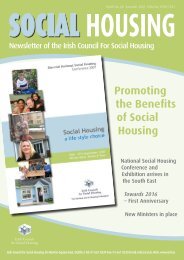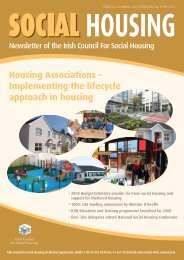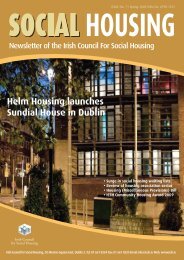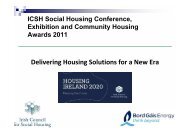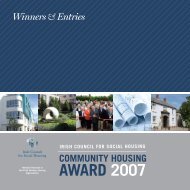National Housing Strategy for People with a Disability 2011 - 2016
National Housing Strategy for People with a Disability 2011 - 2016
National Housing Strategy for People with a Disability 2011 - 2016
You also want an ePaper? Increase the reach of your titles
YUMPU automatically turns print PDFs into web optimized ePapers that Google loves.
• An understanding of the remaining requirement / need <strong>for</strong> wheelchair accessiblestandards, once off specific needs and accessible housing, including the requirementsof children <strong>with</strong> specific design needs.8.27 A consideration of the concept of lifetime housing policy should take account of theneed to provide housing to meet the existing and changing needs of most households atdifferent stages of life, <strong>with</strong>out imposing undue costs on the general population, particularlyin the context of the current economic climate. The most appropriate methods ofimplementation would also need to be established, be it via incentivisation, funding orregulatory methods. It is recommended that consultation by DECLG on these mattersshould commence at an early date.8.28 It is important to acknowledge that the concept of lifetime housing is a long-termstrategy <strong>for</strong> new buildings and, there<strong>for</strong>e, would need to be complemented <strong>with</strong> continuedsupports to facilitate the access needs of people in existing housing.8.29 The design of wheelchair accessible housing has been influenced by the increaseduse of powered wheelchairs and other equipment such as hoists <strong>with</strong>in the home and by therecommended design approach of planning, advocated by some stakeholders, <strong>for</strong> bothimmediate and future access requirements as people age or as a condition progresses.Many of the wheelchairs used <strong>with</strong>in the home are of significant size and, there<strong>for</strong>e, requiregreater space <strong>with</strong>in the home and its environs. Similarly, people who may require the useof a hoist to be lifted will require adequate space <strong>for</strong> safe operation of the hoist. Storagespace is also required <strong>for</strong> wheelchair users as many will have both motorised and manualoperated wheelchairs.8.30 The NDA has issued guidelines <strong>for</strong> the built and external environment in a publicationentitled Building <strong>for</strong> Everyone. These guidelines show how to design, make and managebuildings and external environments to support inclusion, access and usability by everybody.The guidance, which was first published in 2002, is currently being updated and is due to bepublished in <strong>2011</strong>.Provision of Accessible Social <strong>Housing</strong>8.31 There are a number of people <strong>with</strong> disabilities <strong>for</strong> whom the provisions of lifetimehousing would not be sufficient and who will continue to require higher access designstandards and, sometimes, specifically designed housing to meet their needs, e.g. those<strong>with</strong> significant or multiple disabilities who may require the provision of special aids oradaptations, <strong>for</strong> example, powered wheelchairs. <strong>Housing</strong> authorities currently developaccommodation to meet these specific needs on a case by case basis <strong>for</strong> people who qualify<strong>for</strong> social housing.93



